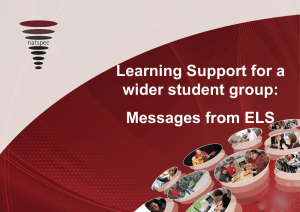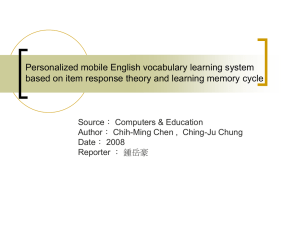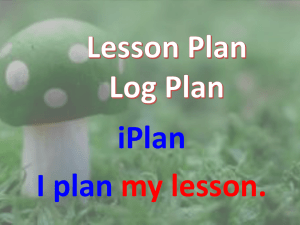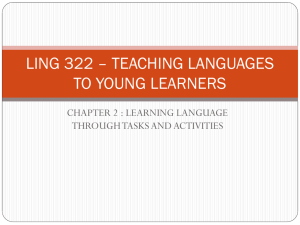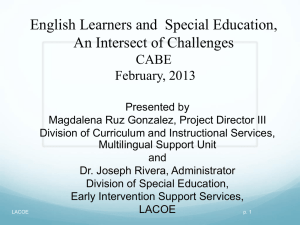Title goes here - National Charter School Resource Center
advertisement
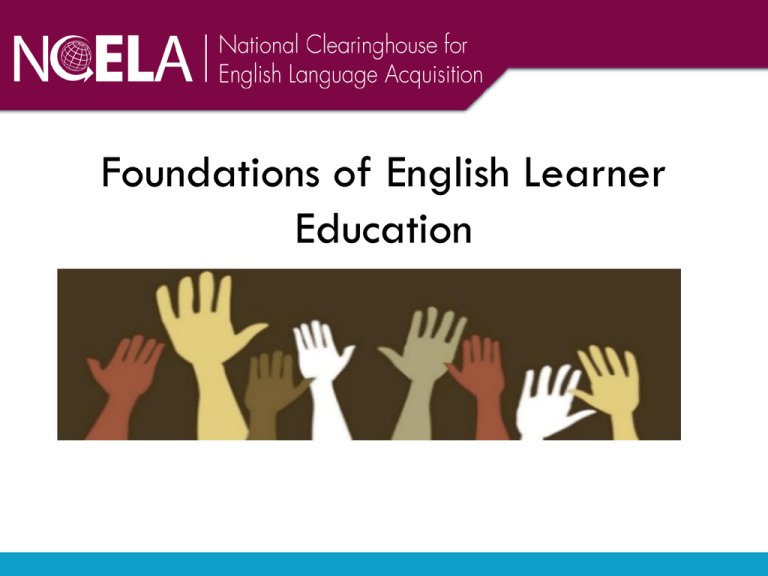
Foundations of English Learner Education Presented by: Igone Arteagoitia, Ph.D. National Clearinghouse for English Language Acquisition* (NCELA) Charter School Directors Meeting Washington D.C. March 3-4, 2014 *NCELA is supported by the U.S. Department of Education’s Office of English Language Acquisition (OELA), awarded to Leed Management Consulting, Inc. in Silver Spring, Maryland, in collaboration with Synergy Enterprises, Inc. and the Center for Applied Linguistics. Eliminating achievement gaps between ELs and non-ELs is NOT a requirement by law, or indicator of a school's success or failure in meeting this goal. Presentation Outline English Learners in Charter Schools English Learner Education English Learners in Charter Schools subtitle Data on English Learners in Charter Schools Four states with highest number of charter schools are among the top 5 with highest Hispanic student1 enrollment (AZ, CA, FL, TX) Estimate: 16.5% of charter students are English learners (ELs), but such data are reported to be incomplete and/or ambiguous (Department of Education, 2008) Missing data due to non-reporting and interpretational issues 2013-14 first year for Department of Education to collect school-level data (rather than district-level) on EL enrollment Four evaluation studies on Latinos and ELs in charter schools 1 Nearly half (45%) of all U.S. Hispanic children are EL students (Kohler & Lazarin, 2007). Evaluation Studies CREDO (15 states and DC) RAND (8 states) NYC charter schools (one city, 54 schools) Mathematica (22 middle schools) English Learner Education Research on Teaching English Learners Generally effective practices are likely to be effective with ELs BUT ELs require additional (instructional) supports ELs need early and ample opportunities to develop proficiency in English Home language can be used to promote academic development Source: Goldenberg (2013) Structures of Support Supporting English Learners Instruction for ELs Effective Teachers and Leaders Conducive School Environments Engaged Parents and Communities System-wide capacity Structures of Support Supporting English Learners Instruction for ELs Effective Teachers and Leaders Conducive School Environments Engaged Parents and Communities System-wide capacity Instruction for ELs Recent shift in educational goals due to college and career readiness standards New standards and assessments for English learners require: teaching and assessing language and content complementary and reinforcing content and English Language Development instruction and assessment English learners can achieve standards without “native-like” control of conventions and vocabulary Recommendations Schools should: Understand implicit language demands of the new standards Support explicit academic language development Provide complementary ELD instruction Support native language and literacy development Practice ongoing formative assessment Structures of Support Supporting English Learners Instruction for ELs Effective Teachers and Leaders Conducive School Environments Engaged Parents and Communities System-wide capacity Effective Teachers & Leaders Under ESEA, all teachers, including teachers of ELs, must be “highly qualified” Three areas of state and district policy: Identifying effective teachers Using information in human resource policies Using information to ensure equity Recommendations Schools and districts should: Align instructional models and teacher qualifications (e.g., bilingual programs) Examine current HR Policies Credentials Leadership of program Professional development programs for teachers of ELs Determine targeted actions Structures of Support Supporting English Learners Instruction for ELs Effective Teachers and Leaders Conducive School Environments Engaged Parents and Communities System-wide capacity Engaged Parents & Community Barriers to involvement: Language barriers Miscommunications about cultural perspectives on parent-teacher involvement and how students learn Previous negative experiences with schools Feelings of intimidation Unfamiliarity with school system Source: Nicolau & Ramos (1990) Recommendations Schools should: Learn about the cultures and language of EL families Build relationships with "experts" who work with EL communities Create an open-door policy (between principal/parents) Provide basic information regarding school policies and regulations in home languages Create a targeted program that considers participants’ needs Create a translated EL newsletter Structures of Support Supporting English Learners Instruction for ELs Effective Teachers and Leaders Conducive School Environments Engaged Parents and Communities System-wide capacity Conducive School Environment Programmatic school environment Segregation vs. inclusion Socio-emotional environment Bullying Recommendations Schools should: Consider programmatic models Increase learning time opportunities Promote EL involvement in extracurricular activities and gifted programs Value linguistic and cultural diversity Foster collaboration among stakeholders Evaluate the school environment Provide professional development about linguistic and cultural diversity Communicate about issues that arise School Showcase El Sol Science and Arts Academy, Santa Ana, CA Rigorous recruitment of teachers that “reflect students and families” Three teachers per grade level After-school program makes the school a community center Promotes parent involvement in nonconventional ways School Showcase YES Prep Gulfton, Houston, TX Rigorous hiring process but generous PD opportunities Expanded school schedule Students visit 20 colleges & universities before graduating School Showcase Raul Yzaguirre School for Success, Houston, TX All HS teachers receive training to teach ELs Employs a full-time parent coordinator to develop a parent curriculum Annual home visits Matriculates nearly 100% of HS graduates to higher education RYSS “grows” its student body, with high student retention rates Takeaways: Structures of Support Multi-faceted process Four structures of support Instruction for ELs Effective teachers Engaged parents and communities Conducive school environments Closing Statement Schools that effectively meet the needs of English Learner students follow this multifaceted approach to provide them with the tools they need to “learn English in a timely manner and receive meaningful access to the rest of a school’s instructional program” Source: Mansukhani & Chinchilla (2013) References Adelman, H.S. & Taylor, L. (2008). Rebuilding for Learning: Addressing Barriers to Learning and Teaching and Re-engaging Students. New York, NY: Scholastic Inc. Casteel, C. J., Ballantyne, K.G. (2010). Professional Development in Action: Improving Teaching for English Learners. National Clearinghouse for English Language Acquisition & Language Instruction Educational Programs. Center for Research on Education Outcomes. (2009). Multiple Choice: Charter School Performance in 16 States. Washington, DC: Author. Clair, N. (2011). Charter Schools and ELLs: An Authorizer and School Leader Guide to Educating ELLs. Chicago, IL: National Association of Charter School Authorizers. Coleman, R. and Goldenberg, C. (2012). The Common Core Challenge for English Language Learners. Principal Leadership, 46–51. Council of Chief State School Officers. (2012). Framework for English Language Proficiency Development Standards corresponding to the Common Core State Standards and the Next Generation Science Standards. Washington, DC: CCSSO. References (cont.) Goldenberg, C. (2013). Unlocking the research on English Learners: What we know—and don’t yet know—about effective instruction. American Educator, 37 (2), 4-11. Government Accountability Office. (2013). Education Needs to Further Examine Data Collection on English Language Learners in Charter Schools. GAO-13-655R. Retrieved from: http://www.gao.gov/products/gao-13-655r Han, Y. (2012). From survivors to leaders: Stages of immigrant parent involvement in schools. In E.G. Kugler (Ed.). Innovative voices in education: Engaging diverse communities(pp. 171-186).Lanham, Maryland: Rowman & Littlefield Publishing. Kim, Y. (2011). Developing a model of effective English teaching for pre-service teacher education. ERIC Document Reproduction Service No. ED520808. King, K., Artiles, A., Kozleski, E.(2013). Professional Learning for Culturally Responsive Teaching. The National Center for Culturally Responsive Educational Systems. Kohler, A.D. & Lazarin, M. (2007). Hispanic education in the United States. National Council of La Raza, Washington, D.C References (cont.) Lazarín, M. (2008). A Race Against the Clock: The Value of Expanded Learning Time for English Language Learners. Center for American Progress. Retrieved from: http://www.americanprogress.org/issues/education/report/2008/12/16/5345/ a-race-against-the-clock/ Lazarín, M, Ortiz-Licon, F. (2010). Next Generation Charter Schools: Meeting the Needs of Latinos and English Language Learners. Center for American Progress. Retreived from: http://www.americanprogress.org/issues/2010/09/pdf/charter_schools.pdf Lyons, J.J. (2014). “Opportunity Lost: The promise of equal and effective education for emerging bilingual students in the Obama administration.” BUENO National Policy Center for Bilingual & Multicultural Education. Mansukhani, S., Chinchilla, F. (2013). Serving English Learners: A Toolkit for Public Charter Schools. Retrieved from: http://www.publiccharters.org/publications/serving-english-language-learnerstoolkit-public-charter-schools/ References (cont.) Nicolau, S., and C.L. Ramos. (1990). Together Is Better: Building Strong Relationships between Schools and Hispanic Parents. New York: Hispanic Policy Development Project. TESOL International Association. (2013). Overview of the Common Core State Standards Initiatives for ELLs. Alexandria, VA: Author. Vera, E. M., Israel, M. S., Coyle, L., Cross, J., Knight-Lynn, L., Mallem, I., Bartucci, G., Goldberger, N. (2012). Exploring the Educational Involvement of Parents of English Learners. School Community Journal, 22(2), 183-202. WIDA. (2012). WIDA’s 2012 Amplification of the ELD Standards. Washington, DC: Author. Retrieved from: http://wida.us/standards/eld.aspx Resources for CCSS Instruction and English Learners Academic Language Development Network http://aldnetwork.org/ Education Connections (Center for Applied Linguistics/ University of Oregon) https://www.obaverse.net/welcome/edconnect Understanding Language (Stanford University) http://ell.stanford.edu/ Professional Development Programs to Support Academic Language Development Guided Language Acquisition Design (GLAD) http://www.projectglad.com/ WIDA LADDER http://ladder.wceruw.org/ Quality Teaching for English Learners (QTEL) http://qtel.wested.org/ Sheltered Instruction Observation Protocol (SIOP) http://www.cal.org/siop/ Department of Education Resources National Clearinghouse for English Language Acquisition (NCELA) http://ncela.ed.gov/ National Clearinghouse for English Language Acquisition (NCELA) Nexus askncela@leedmci.com U.S. Department of Education, National Center for Education Statistics, Common Core of Data (CCD), “Local Education Agency School Universe Survey,” 2010-11. See Digest of Education Statistics, 2012. US Department of Education. (2012) . Providing Effective Teachers for All Students: Examples from Five Districts. Washington, DC. Retrieved from: http://www2.ed.gov/rschstat/eval/teaching/providing-effectiveteachers/report.pdf US Department of Education Family and Community Engagement webpage: http://www2.ed.gov/parents/academic/help/partnership.html Thank you! *NCELA is supported by the U.S. Department of Education’s Office of English Language Acquisition (OELA), awarded to Leed Management Consulting, Inc. in Silver Spring, Maryland, in collaboration with Synergy Enterprises, Inc. and the Center for Applied Linguistics.
